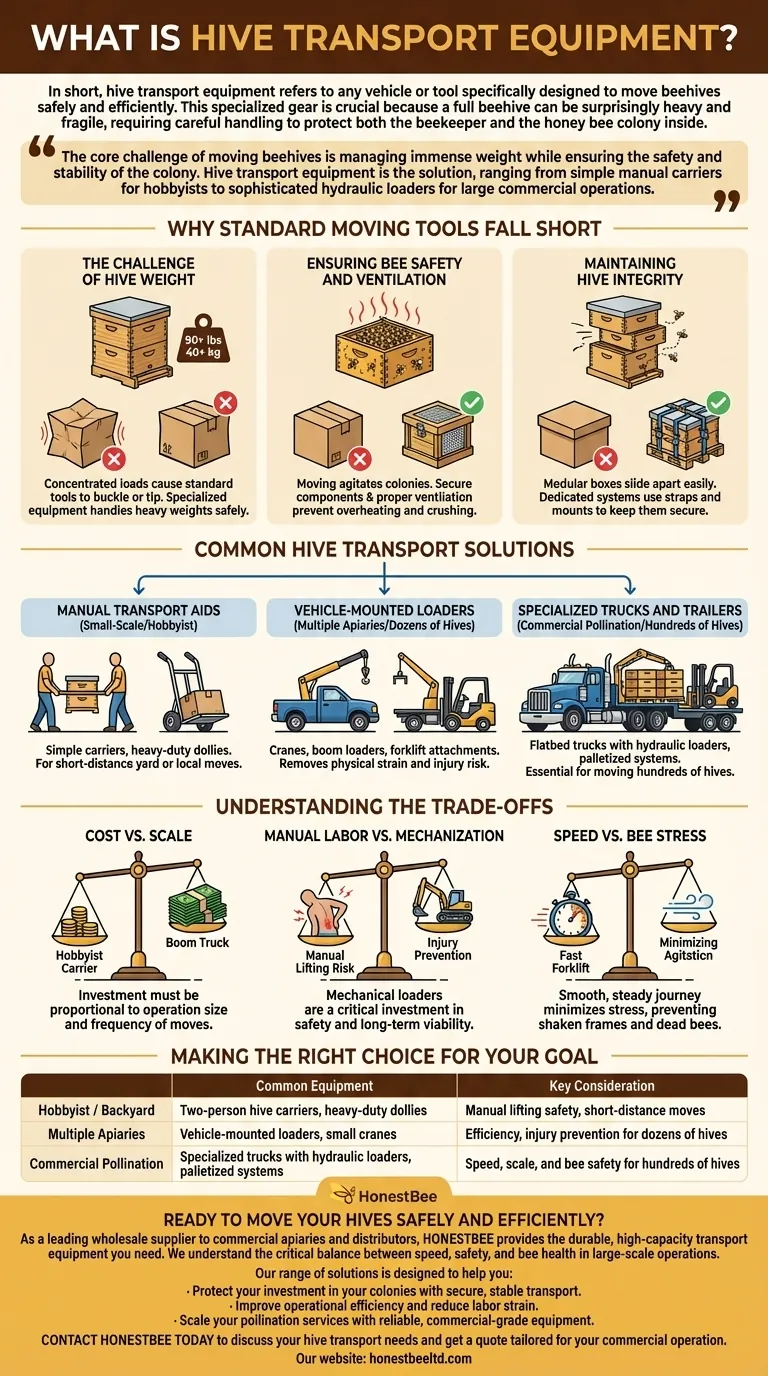In short, hive transport equipment refers to any vehicle or tool specifically designed to move beehives safely and efficiently. This specialized gear is crucial because a full beehive can be surprisingly heavy and fragile, requiring careful handling to protect both the beekeeper and the honey bee colony inside.
The core challenge of moving beehives is managing immense weight while ensuring the safety and stability of the colony. Hive transport equipment is the solution, ranging from simple manual carriers for hobbyists to sophisticated hydraulic loaders for large commercial operations.

Why Standard Moving Tools Fall Short
Transporting a beehive is not like moving a simple box. The unique nature of a living colony presents several challenges that standard equipment is not designed to handle.
The Challenge of Hive Weight
A single, deep hive box filled with honey, pollen, and bees can easily weigh over 90 pounds (40 kg). A full hive with multiple boxes can weigh several hundred pounds, making manual lifting dangerous and impractical.
Transport equipment is built to handle these concentrated loads without buckling or tipping.
Ensuring Bee Safety and Ventilation
Moving agitates a colony. It's critical to secure the hive components so they don't shift and crush bees. Proper transport methods also ensure the hive has adequate ventilation, as a sealed, agitated colony can quickly overheat and perish.
Maintaining Hive Integrity
A standard beehive is a stack of modular boxes. During transit, these boxes can easily slide apart if not properly strapped and secured. Specialized transport systems, like palletized mounts or dedicated hive clamps, prevent this separation.
Common Hive Transport Solutions
The type of equipment used depends entirely on the scale of the beekeeping operation, from backyard hobbyists to commercial pollinators who move thousands of hives at a time.
Manual Transport Aids
For small-scale beekeepers moving a hive across the yard or to a new local apiary, simple tools are often sufficient. This includes two-person hive carriers, which are frames with handles that grip the hive, or heavy-duty hand trucks and dollies.
Vehicle-Mounted Loaders
For beekeepers managing dozens of hives, vehicle-mounted equipment becomes essential. This often involves small cranes, boom loaders, or forklift attachments fitted onto trucks or trailers. These devices remove the physical strain and risk of injury associated with lifting heavy hives.
Specialized Trucks and Trailers
Commercial beekeepers who provide pollination services rely on highly specialized vehicles. These are typically flatbed trucks or trailers equipped with hydraulic loaders or forklifts designed to move dozens or even hundreds of hives at once, often secured to pallets.
Understanding the Trade-offs
Choosing how to transport hives involves balancing cost, safety, and efficiency. Every beekeeper must weigh these factors for their specific situation.
Cost vs. Scale
A hobbyist with two hives does not need a boom truck. The investment in transport equipment must be proportional to the size of your operation and the frequency of moves.
Manual Labor vs. Mechanization
Lifting heavy hives manually carries a significant risk of back injury. While mechanical loaders are an expense, they are a critical investment in personal safety and long-term viability for anyone managing more than a few hives.
Speed vs. Bee Stress
The goal of any hive move is to minimize stress on the colony. While a forklift is fast, the journey itself should be smooth and steady. Rushing the process can lead to shaken frames, dead bees, and an agitated colony at the destination.
Making the Right Choice for Your Goal
Your approach to transport should be dictated by the size and purpose of your apiary.
- If your primary focus is hobby beekeeping: Prioritize safety with two-person hive carriers and plan short moves carefully, typically at night or during cool weather when bees are clustered inside.
- If your primary focus is managing several local apiaries: Invest in a robust hand truck or consider a small, vehicle-mounted lift to prevent injury and increase efficiency.
- If your primary focus is commercial pollination: Professional, purpose-built loaders and flatbed trucks are an essential and non-negotiable part of your business infrastructure.
Ultimately, the right equipment is whatever allows you to move your colonies without harming yourself or your bees.
Summary Table:
| Scale of Operation | Common Equipment | Key Consideration |
|---|---|---|
| Hobbyist / Backyard | Two-person hive carriers, heavy-duty dollies | Manual lifting safety, short-distance moves |
| Multiple Apiaries | Vehicle-mounted loaders, small cranes | Efficiency, injury prevention for dozens of hives |
| Commercial Pollination | Specialized trucks with hydraulic loaders, palletized systems | Speed, scale, and bee safety for hundreds of hives |
Ready to move your hives safely and efficiently?
As a leading wholesale supplier to commercial apiaries and distributors, HONESTBEE provides the durable, high-capacity transport equipment you need. We understand the critical balance between speed, safety, and bee health in large-scale operations.
Our range of solutions is designed to help you:
- Protect your investment in your colonies with secure, stable transport.
- Improve operational efficiency and reduce labor strain.
- Scale your pollination services with reliable, commercial-grade equipment.
Contact HONESTBEE today to discuss your hive transport needs and get a quote tailored for your commercial operation.
Visual Guide

Related Products
- HONESTBEE Advanced Ergonomic Stainless Steel Hive Tool for Beekeeping
- Professional Dual-End Stainless Steel Hive Tool for Beekeeping
- HONESTBEE Professional Long Handled Hive Tool with Precision Cutting Blade
- Professional Multi-Function Stainless Steel Hive Tool
- Wholesales Dadant Size Wooden Bee Hives for Beekeeping
People Also Ask
- What are the features of a regular hive tool? The Essential Multi-Tool for Every Beekeeper
- What is a hive tool and what are its uses? Master Your Hive Inspections with the Essential Beekeeper's Tool
- How should beekeepers handle bees when using a hive tool? Master Calm, Deliberate Techniques
- Why do hive tools have a hole? Unlock the Secret to Efficient Beekeeping
- Why is it important to compare the progress of different hives? A Beekeeper's Key Diagnostic Tool



















